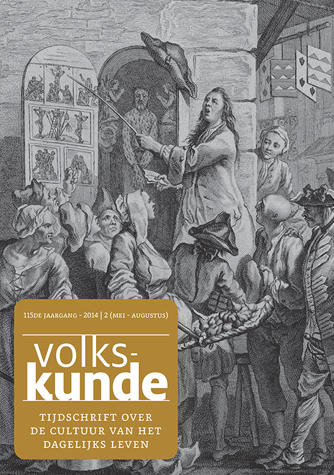V. VANRUYSSEVELDT
Tussen niche en overlevingsstrategie? Rondtrekkende artiesten in het hertogdom Brabant in de tweede helft van de achttiende eeuw
Summary: Itinerant entertainers in Brabant (1766-1775)
Itinerant entertainers (musicians, singers, puppet players, bear dancers and other artists) used to play an important role in popular culture in preindustrial Europe. Negative connotations about these people have prevailed in modern historiography while too little attention has been paid to their social background and professional organization.
This article is based on legal proceedings dealing with vagrancy. It sheds light on the income strategies of 120 ambulant entertainers in the duchy of Brabant in the period 1766-1775. A careful analysis of the individual lawsuits reveals a variety of strategies used to organize their mobile life, ranging from temporary survival strategies to culturally and socially well organized ways of life.
H. GEYBELS
Miraculen onlancx ghebeurt in Scherpen-heuvel. De intellectuele elite over mirakels in de zeventiende eeuw
Summary: Miracles and popular culture (Flanders, seventeenth century)
Miracles are an essential element in religious popular culture. They are usually the basis for the success of pilgrimage sites. If reports of miracles were spread efficiently, a small place of worship could develop into an (inter)national pilgrimage site. The seventeenth century there was an explosion of miracle stories. But the reformers induced the catholic theologians to ponder the phenomenon. Miracles proved not only that the Catholic custom of venerating saints made sense, but many extravagant stories also became a sticking point for the more rational theologians. This contribution investigates the miracle literature related to Scherpenheuvel.
In the reformed Spanish Netherlands, miracles were subject to a double logic: tradition and context. The theologians Numan, De Soto and Wichmans followed the long tradition when justifying miracles. These scholars reverted to Augustine and Thomas Aquinas, the principal authors to provide almost all theological arguments to legitimize miracles. And all three shared the same theology in the same context, following a paradigm that had never been contested in catholic circles.
The counterreformation had a two- pronged approach: the forum externum and the forum internum. The first entailed a duty to defend oneself against Protestantism, while the second entailed an obligation to educate the Catholic congregation. With his book Numan focused especially on the conversion of the heretics and the edification of Catholics. Miracles – as well as ecclesial hierarchy and the veneration of saints – were an extremely polemical issue in the struggle between Catholics and Protestants. That makes sense, because miracles not only justified catholic authority and hierarchy but also legitimized the veneration of saints. These three elements were so intricately intertwined that if one was under fire, the others were to follow.
T. PEETERS
“Sweet-milk cows” in Huizen and “memorable incisents” in Oost Zaandam. Identity and responsibility in two eighteenth century rural chronicles
“Soetemelck koebeesten” in Huizen en “gedenkwaardige voorvallen” in Oost Zaandam. Identiteit en verantwoordelijkheid in twee achttiende-eeuwse plattelandskronieken
Aan de hand van twee achttiende- eeuwse plattelandskronieken, de Memorie ofte Kronijckxke van Lambert Lustigh en de Oostzaandammer Kronijk van Cornelis Veen, geeft dit artikel inzicht in een onderwerp dat nog nooit als zodanig bestudeerd is, namelijk het belang en de functie van kroniekschrijven in vroegmoderne plattelandssamenlevingen. Deze studie laat zien dat het schrijven van een kroniek Lustigh en Veen de mogelijkheid tot zelfexpressie bood middels een genre dat zich hier eenvoudig voor leende. Beide kroniekschrijvers legden gedurende een periode van tien jaar vast wat er in hun gemeenschap en daarbuiten gebeurde. De identiteit, herkomst en overtuiging van beide auteurs zijn te herkennen in zowel de gekozen onderwerpen, voornamelijk lokale aangelegenheden en zaken die het boerenbedrijf betreffen, als in hun interpretaties van allerlei gebeurtenissen, die veelal wijzen op Gods ingrijpen. De kronieken brengen zo iets van de belevingswereld van de achttiende- eeuwse plattelandsbevolking aan het licht.
Bovendien laat deze studie zien dat het schrijven van een plattelandskroniek ook een gevoel van verantwoordelijkheid tegenover de lokale gemeenschap en haar geschiedenis kon impliceren. Beide kronieken weerspiegelen niet alleen de verschillende rollen die de auteurs in de samenleving vervulden, maar het chroniqueren zelf gaf hun ook een nieuwe rol binnen hun gemeenschap. Veen en Lustigh namen namelijk met veel plezier de taak op zich het heden, dat anders verloren zou kunnen gaan, vast te leggen, specifieke kennis te verzamelen over anders onbegrijpelijke gebeurtenissen en zin te geven aan de vaak dramatische werkelijkheid van het dagelijkse leven. Dit aspect van kroniekschrijven als dienst aan de gemeenschap wordt onder meer duidelijk in het feit dat beide auteurs, in tegenstelling tot dagboekschrijvers, wilden overtuigen en tevens gehoord en vertrouwd worden. Uniek aan deze achttiende- eeuwse plattelandskronieken is dus dat ze, in tegenstelling tot (boeren-) dagboeken of officiële geschiede- nissen, persoonlijke expressie samen- brengen met een publieke functie, een – niet altijd erkende – dienst aan de gemeenschap. Verder onderzoek moet uitwijzen of het chroniqueren van het plattelandsleven een veelvoorkomend fenomeen was en of deze tweeledige functie kenmerkend is voor acht- tiende-eeuwse plattelandskronieken.


